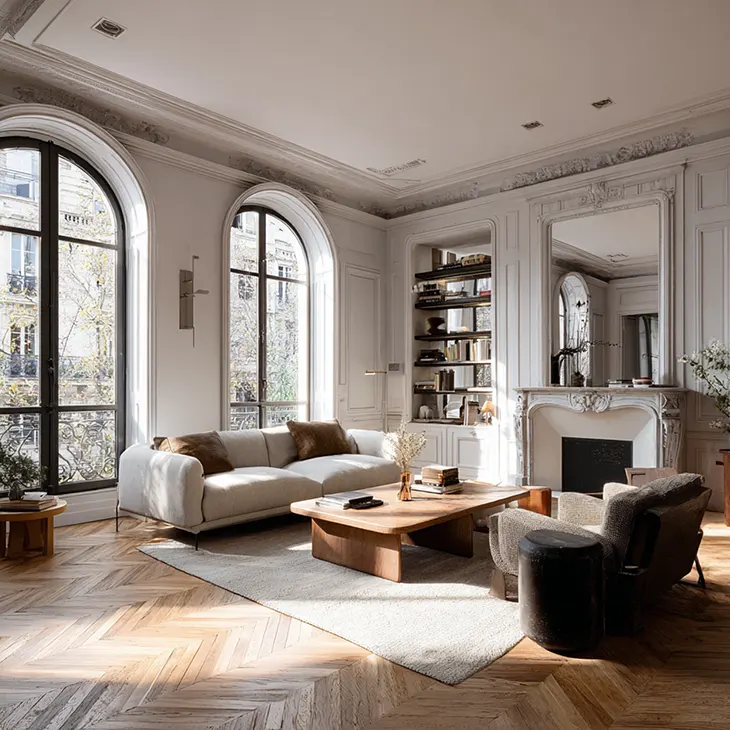
In 2025, real estate marketing demands fresh approaches, and 3D renderings for real estate have become a powerful tool to attract high-value buyers. Want to know how the industry is changing, the impact of photorealistic 3D rendering on property sales, and the benefits your business can get from using 3D rendering services? Find everything in this article.
The Shift from Traditional to Visual-First Real Estate Marketing
Do you remember the times when real estate presentation visuals were limited only to photos (and less frequently, videos)? While this approach worked well 5-10 years ago, modern buyers are much more demanding and want something more than pictures to make a decision. Today’s audience expects an immersive experience to visualize not just the space, but the lifestyle that comes with it.
This shift has pushed the industry from traditional marketing tactics like professional photos and static online listings to a visual-first strategy. Being at the forefront of this transformation, real estate 3D visualization allows developers and agents to showcase properties with photorealistic detail. These high-quality renders offer a far more engaging way to present listings, especially in competitive or luxury markets where first impressions matter most.
In addition to interior and exterior renderings, virtual tours for real estate allow potential clients to explore homes from anywhere in the world, saving them time while helping to make a buying decision.
With such a demand for real estate 3D rendering services, top companies in the US are catching up with the trends and offering high-quality 3D home visualizations, immersive real estate visuals, and even virtual property walkthroughs.

How Photorealistic 3D Rendering Boosts Buyer Confidence
In today’s real estate landscape, visuals aren’t just an enhancement – they’re the foundation of buyer engagement and trust. Through architectural visualization, interior renderings, 3D floor plans, and animation, real estate professionals are turning traditional listings into powerful digital property showcases.
So, what experience does a 3D rendering service provide for clients, and how does it benefit businesses?
Realistic simulation
Modern buyers expect more than static images – they want to feel the space before they ever step inside. That’s where photorealistic renders come in. A well-crafted photorealistic 3D rendering can simulate natural lighting, material textures, and realistic decor, transforming a blueprint into an engaging visual story. However, CGI for real estate (computer-generated imagery) goes beyond simple aesthetics: it delivers storytelling. Whether it’s a luxury condo or a commercial development, high-resolution property images and detailed 3D floor plans allow prospects to interact with a listing dynamically, even if the property hasn’t been built yet.
Time saver
In a fast-moving market, time is critical for both buyers and sellers. Photorealistic real estate 3D visualization speeds up the sales process by reducing the need for multiple in-person visits and minimizing back-and-forth communication. Comprehensive real estate renderings allow potential buyers to explore layouts, finishes, and spatial flow in a single session. This efficiency is especially beneficial for international clients or remote investors who rely on quality property visualization techniques and interactive content to evaluate options.
Informed decision making
Quality architectural visualization offers a high level of clarity so that buyers don’t have to guess about key property details. From interior renderings to exterior perspectives, every angle is covered. Modern real estate rendering services, like those of Fortes Vision, provide realistic previews that help buyers assess everything from furniture placement to natural light patterns. As a result, clients and investors can make confident, well-informed decisions from the comfort of their home or office.

Future Trends in Real Estate Visualization
As the real estate industry continues to evolve, so do the tools and techniques used to attract, inform, and convert buyers. From virtual experiences to immersive marketing strategies, the future of real estate visualization is shaping how properties are presented and perceived. Below are three key trends redefining visual content in real estate marketing.
Virtual tours
Virtual property tours have transformed how buyers explore properties. Instead of relying on basic property marketing visuals or scheduling multiple in-person visits, buyers can now navigate homes remotely and get a true sense of layout, space, and atmosphere. These tours do more than just show rooms – they tell a story, helping buyers imagine what it would feel like to actually live there.
For agents and developers, this means reaching a wider audience and creating a stronger emotional connection through high-quality real estate renderings, from the first click.
Pre-construction marketing
Pre-construction sales have always been a challenge. Selling a space that doesn’t yet exist requires a lot of effort, and this is where advanced property visualization techniques step in. By using real estate design assets like virtual staging, lighting, and material previews, developers can showcase future properties with confidence.
The ability to market unbuilt properties through real estate marketing tools such as 3D walkthroughs and CGI visuals not only builds anticipation but also accelerates buyer interest and pre-sales.
Investment engagement
Visualization is no longer just for buyers – it’s a powerful tool for engaging investors. With polished real estate branding visuals and storytelling visualization, developers can clearly convey a project’s scope, potential, and value. This data-backed approach enhances investor confidence and helps turn abstract plans into concrete opportunities.
That said, real estate 3D visualization empowers buyers and investors to make faster, more confident decisions. As the industry continues to evolve, leveraging real estate rendering services will be key to staying ahead.



















